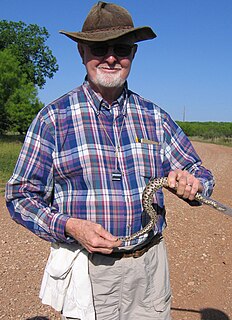
Phyllodactylus is a genus of geckos distributed in South America and Central America, and as far north as the southern United States. They are commonly known as "leaf-toed geckos" in their native range, and otherwise as American leaf-toed geckos to distinguish them from unrelated genera with similar feet.
The western leaf-toed gecko is a species of gecko. It is endemic to Peru. It was described by Johann Jakob von Tschudi in 1845.

The narrow leaf-toed gecko is a medium-sized gecko with a maximum snout-vent length of 57 mm.

Phyllodactylus xanti is a species of lizard in the family Phyllodactylidae. It is endemic to northwestern Mexico. It is also known as the leaf-toed gecko or Raza Island leaf-toed gecko when referring to the subspecies from the Isla Rasa; at present, there are altogether four recognized subspecies, while several more have been recognized previously.

James Ray Dixon was professor emeritus and curator emeritus of amphibians and reptiles at the Texas Cooperative Wildlife Collection at Texas A&M University. He lived in El Campo, Texas throughout most of his childhood. He published prolifically on the subject of herpetology in his distinguished career, authoring and co-authoring several books, book chapters, and numerous peer reviewed notes and articles, describing two new genera, and many new species, earning him a reputation as one of the most prominent herpetologists of his generation. His main research focus was morphology based systematics of amphibians and reptiles worldwide with emphasis on Texas, US, Mexico, Central America, and South America, although bibliographies, conservation, ecology, life history and zoogeography have all been the subjects of his extensive publications.
Donald Ward Tinkle was a prominent herpetologist, ecologist, and evolutionary biologist at the University of Michigan until his illness and death at age 49. He is best known for his intensive demographic studies of lizards, which involved full censuses of local populations repeated over several years to obtain life table parameters such as age at maturity, survivorship, and reproductive effort. He was a pioneer in developing life history theory along with key students including Henry Wilbur, Michael Hirshfield, and Arthur Dunham, and he was an important collaborator with Dr. Richard D. Alexander in the application of individual selection theory and sociobiological ideas to varied organisms including humans.
The Lima leaf-toed gecko has been registered in six archeological sites in Lima, Peru, where it is endemic. It is considered a species in critical danger.

The peninsula leaf-toed gecko is a medium-sized gecko. It is found in southern California (USA) and Baja California (Mexico), including many islands in Gulf of California as well as Islas Magdalena and Santa Margarita off the west coast of Baja California.

The Barbados leaf-toed gecko is a species of gecko endemic to the Caribbean island-nation of Barbados. It is the only known leaf-toed gecko in the Lesser Antilles.
Phyllodactylus ventralis, the Margarita leaf-toed gecko, is a species of lizard found in northern Colombia, Venezuela, and according to some sources, also Grenada and other Windward Islands.
The Barrington leaf-toed gecko is a species of lizard in the family Phyllodactylidae. The species is endemic to Santa Fe Island in the Galapagos.
Baur's leaf-toed gecko is a species of lizard in the family Phyllodactylidae. The species is endemic to the Galápagos Islands.

The Guerreran leaf-toed gecko, also known commonly as the desert leaf-toed gecko and the salamanquesa de Guerrero in Spanish, is a species of lizard in the family Phyllodactylidae. The species is endemic to Mexico.
The Catalina Island leaf-toed gecko is a species of gecko. It is endemic to Isla Santa Catalina in Gulf of California, Mexico.
Darwin's leaf-toed gecko is a species of lizard in the family Phyllodactylidae. The species is endemic to San Cristóbal Island in the Galapagos.
Davis's leaf-toed gecko, also known commonly as Davis' leaf-toed gecko, is a species of lizard in the family Phyllodactylidae. The species is endemic to Mexico.
The Pardita Norte leaf-toed gecko is a species of gecko. It is endemic to Isla Partida in Mexico.
The Rio Marquez Valley gecko is a species of gecko. It is endemic to Mexico.

Phyllodactylus reissii, also known commonly as Peters' leaf-toed gecko or the coastal leaf-toed gecko, is a species of lizard in the family Phyllodactylidae. The species is endemic to northwestern South America.

The San Lucan gecko is a species of gecko. It is endemic to Mexico.







